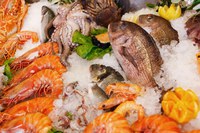Prairie Fare: How often do you eat seafood?
(Click an image below to view a high-resolution image that can be downloaded)
Let’s do an activity. Think back to your food choices during the past week.
How many times did you eat seafood, including any type of fish or shellfish?
Did you have seafood two times, or enjoy about 8 ounces of seafood last week? That’s the current recommendation from the latest Dietary Guidelines for Americans.
However, if you are allergic to fish or shellfish, I hope you avoided it completely.
According to most definitions, “seafood” includes any edible marine life, including fresh and saltwater fish, crustaceans (shrimp, lobster) and molluscan shellfish (oysters, scallops, mussels).
I grew up calling marine life such as walleye from Midwestern lakes “fish.” It all counts toward the 8-ounce weekly recommendation.
Recently I was at a conference in Rhode Island, so I was right by the Atlantic Ocean. Actually, I was closer to a hurricane than I have ever wanted to be.
I enjoyed a type of seafood every day, including fish and chips, clam chowder, lobster mac and cheese, lobster bisque, sautéed shrimp and cod fish tacos.
I think I am growing fins or a shell.
Growing up in the Midwest, we did not have seafood at home very often. In the summer, we had fresh fish if a fishing expedition was successful. We had tuna noodle hotdish or tuna salad now and then. Fish sticks with mashed potatoes and creamed peas showed up on our school menu on a rotation.
If my mother was preparing food to impress guests, a can of pink salmon would appear on the counter for some sort of recipe.
We all need variety in our diets throughout all of our food choices. Fish and seafood are within the protein group, along with meat, poultry, eggs, beans, peas, lentils, soy products, nuts and seeds.
Seafood provides key nutrients including brain- and heart-healthy omega-3 fats, along with iron, iodine and choline.
Eating a variety of fish, lean meat and poultry, fruits, vegetables, legumes, whole grains, and healthy beverages may decrease our risk of overweight, decrease our risk for certain types of cancer, and promote bone and heart health.
For pregnant or breastfeeding women, the Dietary Guidelines for Americans recommends 8 to 12 ounces of seafood weekly from choices that are lower in mercury.
Mercury is a heavy metal that may contaminate some water from industrial pollution. Too much mercury can affect your kidneys, lungs, heart and digestive system. The good news is that the risk is fairly low. The health risk depends on where the fish were harvested and how much you eat.
Most state game and fish departments provide fish consumption advisories about the mercury content of fish.
Swordfish, shark, king mackerel and marlin are among the fish highest in mercury. Canned light tuna, salmon, shrimp and catfish are among the fish lowest in mercury.
Children should only be fed fish from the “best choices” list provided by the Food and Drug Administration (available at www.fda.gov/food/consumers/advice-about-eating-fish#nutrients).
A serving of fish for an adult is 4 ounces (about the size of the palm of an adult’s hand), while a serving size of fish for a child is 1 ounce at age 1 to 3, 2 ounces at age 4 to 7, 3 ounces at age 8 to 10, and 4 ounces for 11 and older.
Fresh seafood can be costly depending on where you live. Try other forms of seafood, including canned and frozen.
Canned fish can be used in patties, with pasta, on salads, in dips and in tacos. To reduce fat and calories, opt for the non-fried options whenever possible.
My “fish and chips” in Rhode Island was not the healthiest choice, by the way. Fried fish is best viewed as a once-in-a-while treat.
Try grilled, broiled or steamed seafood to reduce the amount of added fat.
Add a little variety to your protein selections. Here’s a quick and easy sandwich that pairs well with soup. The NDSU Extension Field to Fork website at www.ag.ndsu.edu/fieldtofork includes a delicious tomato-basil soup with the tomato collection under the “resources” tab.
Tuna Melt
2 (5-ounce) cans chunk light tuna in water, drained
1 medium red onion, chopped
2 tablespoons mayonnaise
1 tablespoons lemon juice
1/8 teaspoon ground pepper
Salsa to taste
4 slices whole-wheat bread, toasted
¼ cup finely shredded cheddar cheese
Preheat broiler. Toast bread. Combine tuna, onion, mayonnaise, lemon juice, salsa and pepper in a medium bowl. Spread one-fourth of tuna mixture on each slice of toast; top with cheese. Place on a baking sheet and broil until cheese is bubbling and golden brown, three to five minutes.
Makes four servings. Each serving has 250 calories, 7 grams (g) fat, 32 g protein, 21 g carbohydrate and 400 milligrams sodium.
Julie Garden-Robinson, Ph.D., R.D., L.R.D., is a North Dakota State University Extension food and nutrition specialist and professor in the Department of Health, Nutrition and Exercise Sciences.)
NDSU Agriculture Communication – Sept. 21, 2023
Source: Julie Garden-Robinson, 701-231-7187, julie.garden-robinson@ndsu.edu
Editor: Elizabeth Cronin, 701-231-7881, elizabeth.cronin@ndsu.edu




